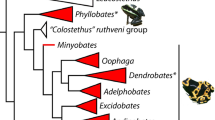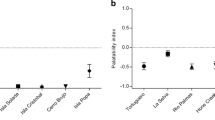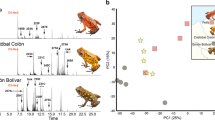Abstract
Poison frogs are well known for their ability to sequester alkaloids from their diet of leaf-litter arthropods for use in defense against predators and pathogens. Australian frogs in the genus Pseudophryne (Myobatrachidae) represent an understudied lineage of poison frogs, with a unique ability to both sequester dietary alkaloids and synthesize pseudophrynamine alkaloids. Herein, we describe the alkaloid profiles and diet of six species of Pseudophryne (P. guentheri [Boulenger, 1882], P. occidentalis [Parker, 1940], P. semimarmorata [Lucas, 1892], P. dendyi [Lucas 1892], P. bibronii [Günther, 1859], and P. coriacea [Keferstein, 1868]) to gain a better understanding of how alkaloid defenses and diet are related within and among species. We characterized and quantified alkaloids using Gas Chromatography-Mass Spectrometry (GC-MS), and assessed diet by way of dissection and examination of stomach contents using light microscopy. We found that alkaloid profiles varied significantly among species, with pumiliotoxins (dietary-derived) and pseudophrynamines (biosynthesized) being the most abundant alkaloids. Pseudophryne bibronii and P. dendyi contained mostly dietary-derived alkaloids, whereas P. coriacea, P. guentheri, P. semimarmorata, and P. occidentalis possessed mostly biosynthesized alkaloids. The stomachs of all the studied species were largely empty, containing mostly soil and few partially digested insects. Our data suggest that frogs eat minimally during the breeding season. Therefore, a decrease in dietary alkaloids may be compensated by the biosynthesized pseudophrynamines, which could allow Australian poison frogs to remain defended from predators during this vulnerable time period.





Similar content being viewed by others
Data availability
The dataset generated during and/or analyzed during the current study are available from the corresponding author on reasonable request.
Code availability
Not applicable
References
Alvarez-Buylla A, Payne CY, Vidoudez C et al (2022) Molecular physiology of pumiliotoxin sequestration in a poison frog. PLOS ONE 17:e0264540. https://doi.org/10.1371/journal.pone.0264540
Barker J, Grigg G, Tyler M (1995) A field guide to Australian frogs. Surrey Beatty 5:69
Basham EW, Saporito RA, González-Pinzón M et al (2021) Chemical defenses shift with the seasonal vertical migration of a Panamanian poison frog. Biotropica 53:28–37. https://doi.org/10.1111/btp.12842
Blount JD, Speed MP, Ruxton GD, Stephens PA (2009) Warning displays may function as honest signals of toxicity. Proc Biol Sci R Soc 276:871–7. https://doi.org/10.1098/rspb.2008.1407
Bolton SK, Dickerson K, Saporito RA (2017) Variable alkaloid defenses in the dendrobatid poison frog Oophaga pumilio are perceived as differences in palatability to arthropods. J Chem Ecol 43:273. https://doi.org/10.1007/s10886-017-0827-y
Bonansea M, Vaira M (2012) Geographic and intrapopulational variation in colour and patterns of an aposematic toad, Melanophryniscus rubriventris (Amphibia, Anura, Bufonidae). Amphibia-Reptilia 33:11–24. https://doi.org/10.1163/156853811X619754
Brunetti AE, Merib J, Carasek E et al (2015) Frog volatile compounds: application of in vivo SPME for the characterization of the odorous Secretions from two species of Hypsiboas treefrogs. J Chem Ecol 41:360–372. https://doi.org/10.1007/s10886-015-0564-z
Byrne PG, Silla AJ (2023) Lifetime breeding-site and nest-site fidelity in a declining terrestrial toadlet: evidence for a win-stay/lose-shift strategy. Front Conserv Sci 4:52
Cei JM, Erspamer V, Roseghini M (1968) Taxonomic and evolutionary significance of biogenic amines and polypeptides in amphibian skin. II. Toads of the genera Bufo and Melanophryniscus. Systematic Zoology 17:232–245. https://doi.org/10.2307/2412002
Conlon JM, Mechkarska M, Ahmed E et al (2011) Purification and properties of antimicrobial peptides from skin secretions of the Eritrea clawed frog Xenopus clivii (Pipidae). Comp Biochem Physiol Part C Toxicol Pharmacol 153:350–354. https://doi.org/10.1016/j.cbpc.2010.12.007
Conlon JM, Mechkarska M, Ahmed E et al (2011) Host defense peptides in skin secretions of the Oregon spotted frog Rana pretiosa: implications for species resistance to chytridiomycosis. Dev Comp Immunol 35:644–649. https://doi.org/10.1016/j.dci.2011.01.017
Daly JW, Myers CW, Whittaker N (1987) Further classification of skin alkaloids from Neotropical poison frogs (Dendrobatidae), with a general survey of toxic/noxious substances in the Amphibia. Toxicon 25:1023–1095
Daly JW, Garraffo HM, Pannell LK et al (1990) Alkaloids from Australian frogs (Myobatrachidae): Pseudophrynamines and Pumiliotoxins. J Nat Prod 53:407–421. https://doi.org/10.1021/np50068a020
Daly JW, Secunda SI, Garraffo HM et al (1994) An uptake system for dietary alkaloids in poison frogs (Dendrobatidae). Toxicon 32:657–663
Daly JW, Garraffo HM, Jain P et al (2000) Arthropod-frog connection: decahydroquinoline and pyrrolizidine alkaloids common to microsympatric myrmicine ants and dendrobatid frogs. J Chem Ecol 26:73–85. https://doi.org/10.1023/A:1005437427326
Daly JW, Garraffo HM, Spande TF et al (2003) Evidence for an enantioselective pumiliotoxin 7-hydroxylase in dendrobatid poison frogs of the genus Dendrobates. Proc Natl Acad Sci USA 100:11092–7. https://doi.org/10.1073/pnas.1834430100
Daly JW, Noimai N, Kongkathip B et al (2004) Biologically active substances from amphibians: preliminary studies on anurans from twenty-one genera of Thailand. Toxicon 44:805–815. https://doi.org/10.1016/j.toxicon.2004.08.016
Daly JW, Spande TF, Garraffo HM (2005) Alkaloids from amphibian skin: A tabulation of over eight-hundred compounds. J Nat Prod 68:1556–1575
Daly JW, Wilham JM, Spande TF et al (2007) Alkaloids in bufonid toads (Melanophryniscus): temporal and geographic determinants for two Argentinian species. J Chem Ecol 33:871–887. https://doi.org/10.1007/s10886-007-9261-x
Daly JW, Garraffo HM, Spande TF et al (2008) Individual and geographic variation of skin alkaloids in three swamp-forest species of Madagascan poison frogs (Mantella). J Chem Ecol 34:252–279. https://doi.org/10.1007/s10886-015-0616-4
Daly JW, Ware N, Saporito RA et al (2009) N-Methyldecahydroquinolines: an unexpected class of alkaloids from Amazonian poison frogs (Dendrobatidae). J Nat Prod 72:1110–1114. https://doi.org/10.1021/np900094v
Donnellan SC, Mahony MJ, Bertozzi T (2012) A new species of Pseudophryne (Anura: Myobatrachidae) from the central Australian ranges. Zootaxa 3476:69–85
Dos Santos TG, Maneyro R, Cechin SZ, Haddad CFB (2011) Breeding habitat and natural history notes of the toad Melanophryniscus pachyrhynus (Miranda-Ribeiro, 1920) (Anura, Bufonidae) in southern Brazil. Herpetol Bull 116:15–18
Erspamer V (1994) Bioactive secretions of the amphibian integument. In: Amphibian Biology. pp 178–350.
Flier J, Edwards MW, Daly JW, Myers CW (1980) Widespread occurrence in frogs and toads of skin compounds interacting with the Ouabain site of Na+, K+-ATPase. Science 208:503–505. https://doi.org/10.1126/science.6245447
Garraffo HM, Andriamaharavo NR, Vaira M et al (2012) Alkaloids from single skins of the Argentinian toad Melanophryniscus rubriventris (ANURA, BUFONIDAE): An unexpected variability in alkaloid profiles and a profusion of new structures. SpringerPlus 1:51. https://doi.org/10.1186/2193-1801-1-51
Gonzalez M, Palacios-Rodriguez P, Hernandez-Restrepo J et al (2021) First characterization of toxic alkaloids and volatile organic compounds (VOCs) in the cryptic dendrobatid Silverstoneia punctiventris. Front Zool 18:39. https://doi.org/10.1186/s12983-021-00420-1
Hovey KJ, Seiter EM, Johnson EE, Saporito RA (2018) Sequestered alkaloid defenses in the dendrobatid poison frog Oophaga pumilio provide variable protection from microbial pathogens. J Chem Ecol 44:312–325. https://doi.org/10.1007/s10886-018-0930-8
Hunter D, Osborne W, Smith M, McDougall K (2009) Breeding habitat use and the future management of the critically endangered Southern Corroboree Frog. Ecol Manag Restor 10:S103–S109. https://doi.org/10.1111/j.1442-8903.2009.00461.x
Jeckel AM, Bolton SK, Waters KR et al (2022) Dose-dependent alkaloid sequestration and N-methylation of decahydroquinoline in poison frogs. J Exp Zool Part A Ecol Integr Physiol 337:537–546. https://doi.org/10.1002/jez.2587
Jeckel AM, Saporito RA, Grant T (2015) The relationship between poison frog chemical defenses and age, body size, and sex. Front Zool 12:27. https://doi.org/10.1186/s12983-015-0120-2
Jones TH, Gorman JST, Snelling RR et al (1999) Further alkaloids common to ants and frogs: Decahydroquinolines and a Quinolizidine. J Chem Ecol 25:1179–1193
Lawrence J, Rojas B, Blanchette A et al (2023) Linking predator responses to alkaloid variability in poison frogs. J Chem Ecol 5:49. https://doi.org/10.1007/s10886-023-01412-7
Lawrence JP, Mahony M, Noonan BP (2018) Differential responses of avian and mammalian predators to phenotypic variation in Australian Brood Frogs. PLoS ONE 13:e0195446
Lawrence JP, Rojas B, Fouquet A et al (2019) Weak warning signals can persist in the absense of gene flow. Proc Natl Acad Sci 116:19037–19045. https://doi.org/10.1073/pnas.1901872116
Lindström L, Alatalo RV, Lyytinen A, Mappes J (2001) Strong antiapostatic selection against novel rare aposematic prey. Proc Natl Acad Sci USA 98:9181–9184. https://doi.org/10.1073/pnas.161071598
Mappes J, Marples N, Endler JA (2005) The complex business of survival by aposematism. Trends Ecol Evol 20:598–603. https://doi.org/10.1016/j.tree.2005.07.011
Martínez MM, Ortega MSC, Lopera JMH, Morales JAR (2019) Diet of the yellow striped poison frog, Dendrobates truncatus (Cope, 1861) (Anura: Dendrobatidae) from the Middle Magdalena river valley, Colombia. Herpetol Notes 12:1185–1191
McFadden M, Harlow P, Kozlowski S, Purcell D (2010) Toe-twitching during feeding in the Australian Myobatrachid frog, Pseudophryne corroboree. Herpetol Rev 41:153–154
McGugan JR, Byrd GD, Roland AB et al (2016) Ant and mite diversity drives toxin variation in the Little Devil Poison Frog. J Chem Ecol 42:537–551. https://doi.org/10.1007/s10886-016-0715-x
Mebs D, Maneyro R, Pogoda W (2007) Further studies on pumiliotoxin 251D and hydroquinone content of the skin secretion of Melanophryniscus species (Anura, Bufonidae) from Uruguay. Toxicon 50:166–169. https://doi.org/10.1016/j.toxicon.2007.02.017
Mebs D, Pogoda W, Maneyro R, Kwet A (2005) Studies on the poisonous skin secretion of individual red bellied toads, Melanophryniscus montevidensis (Anura, Bufonidae), from Uruguay. Toxicon 46:641–650. https://doi.org/10.1016/j.toxicon.2005.07.004
Mebs D, Wagner MG, Pogoda W et al (2007) Lack of bufadienolides in the skin secretion of red bellied toads, Melanophryniscus spp. (Anura, Bufonidae), from Uruguay. Compar Biochem Physiol Part C Toxicol Pharmacol 144:398–402. https://doi.org/10.1016/j.cbpc.2006.11.009
Mitchell NJ (2001) Males call more from wetter nests: effects of substrate water potential on reproductive behaviours of terrestrial toadlets. Proc R Soc Lond B 268:87–93. https://doi.org/10.1098/rspb.2000.1334
Moskowitz NA, Dorritie B, Fay T et al (2020) Land use impacts poison frog chemical defenses through changes in leaf litter ant communities. Neotrop Biodiver 6:75–87
OEH NSW (2012) National recovery plan for the Southern Corroboree Frog Pseudophryne corroboree and Northern Corroboree Frog Pseudophryne pengilleyi. Office of Environment and Heritage (NSW)
Pacheco EO, Ceron K, Akieda PS, Santana DJ (2021) Diet and morphometry of two poison frog species (Anura, Dendrobatidae) from the plateaus surrounding the Pantanal of Mato Grosso do Sul state, Brazil. Stud Neotrop Fauna Environ 56:99–107. https://doi.org/10.1080/01650521.2020.1746098
Pengilley RK (1973) Breeding biology of some species of Pseudophryne (Anura: Leptodactylidae) of the Southern Highlands. New South Wales Aust Zool 18:15–30
Protti-Sánchez F, Quirós-Guerrero L, Vásquez V et al (2019) Toxicity and alkaloid profiling of the skin of the Golfo Dulcean Poison Frog Phyllobates vittatus (Dendrobatidae). J Chem Ecol 45:914–925. https://doi.org/10.1007/s10886-019-01116-x
Roberts SM, Stuart-Fox D, Medina I (2022) The evolution of conspicuousness in frogs: When to signal toxicity? J Evol Biol 35:1455–1464. https://doi.org/10.1111/jeb.14092
Rodríguez A, Poth D, Schulz S, Vences M (2011) Discovery of skin alkaloids in a miniaturized eleutherodactylid frog from Cuba. Biol Lett 7:414–418. https://doi.org/10.1098/rsbl.2010.0844
Rojahn J, Gleeson D, Furlan EM et al (2018) Monitoring post-release survival of the northern corroboree frog, Pseudophryne pengilleyi, using environmental DNA. Wildlife Res 45:620–626. https://doi.org/10.1071/WR17179
Santos JC, Coloma LA, Cannatella DC (2003) Multiple, recurring origins of aposematism and diet specialization in poison frogs. Proc Natl Acad Sci USA 100:12792–12797. https://doi.org/10.1073/pnas.2133521100
Santos RR, Grant T (2011) Diel pattern of migration in a poisonous toad from Brazil and the evolution of chemical defenses in diurnal amphibians. Evolut Ecol 25:249–258. https://doi.org/10.1007/s10682-010-9407-0
Saporito RA, Donnelly MA, Jain P et al (2007) Spatial and temporal patterns of alkaloid variation in the poison frog Oophaga pumilio in Costa Rica and Panama over 30 years. Toxicon 50:757–778
Saporito RA, Donnelly MA, Madden AA et al (2010) Sex-related differences in alkaloid chemical defenses of the dendrobatid frog Oophaga pumilio from Cayo Nancy, Bocas del Toro, Panama. J Nat Prod 73:317–21. https://doi.org/10.1021/np900702d
Saporito RA, Donnelly MA, Norton RA et al (2007) Oribatid mites as a major dietary source for alkaloids in poison frogs. Proc Nat Acad Sci USA 104:8885–90. https://doi.org/10.1073/pnas.0702851104
Saporito RA, Donnelly MA, Spande TF, Garraffo HM (2012) A review of chemical ecology in poison frogs. Chemoecology 22:159–168. https://doi.org/10.1007/s00049-011-0088-0
Saporito RA, Spande TF, Martin GH, A. Donnelly M, (2009) Arthropod alkaloids in poison frogs: a review of the ‘Dietary Hypothesis.’ Heterocycles 79:277. https://doi.org/10.3987/REV-08-SR(D)11
Saporito RA, Garraffo HM, Donnelly MA et al (2004) Formicine ants: an arthropod source for the pumiliotoxin alkaloids of dendrobatid poison frogs. Proc Natl Acad Sci USA 101:8045–50. https://doi.org/10.1073/pnas.0402365101
Saporito RA, Norton RA, Garraffo MH, Spande TF (2015) Taxonomic distribution of defensive alkaloids in Nearctic oribatid mites (Acari, Oribatida). Exp Appl Acarol 67:317–333. https://doi.org/10.1007/s10493-015-9962-8
Skerratt LF, Berger L, Clemann N et al (2016) Priorities for management of chytridiomycosis in Australia: saving frogs from extinction. Wildlife Res 43:105. https://doi.org/10.1071/WR15071
Smith BP, Tyler MJ, Kaneko T et al (2002) Evidence for biosynthesis of pseudophrynamine alkaloids by an Australian myobatrachid frog (Pseudophryne) and for sequestration of dietary pumiliotoxins. J Nat Prod 65:439–447
Summers K, Speed MP, Blount JD, Stuckert AMM (2015) Are aposematic signals honest? A review. J Evol Biol 28:1583–1599. https://doi.org/10.1111/jeb.12676
Takada W, Sakata T, Shimano S et al (2005) Scheloribatid mites as the source of pumiliotoxins in dendrobatid frogs. J Chem Ecol 31:2403–2415. https://doi.org/10.1007/s10886-005-7109-9
Toledo RC, Jared C (1995) Cutaneous granular glands and amphibian venoms. Comp Biochem Physiol Part A Physiol 111:1–29. https://doi.org/10.1016/0300-9629(95)98515-I
Umbers KDL, Riley JL, Kelly MBJ et al (2019) Educating the enemy: Harnessing learned avoidance behavior in wild predators to increase survival of reintroduced southern corroboree frogs. Conserv Sci Pract 5:139. https://doi.org/10.1111/csp2.139
Vaira M (2005) Annual variation of breeding patterns of the toad, Melanophryniscus rubriventris (Vellard, 1947). Amphibia-Reptilia 26:193–199. https://doi.org/10.1163/1568538054253519
Valderrama-Vernaza M, Ramírez-Pinilla MP, VíH Serrano-Cardozo (2009) Diet of the Andean Frog Ranitomeya virolinensis (Athesphatanura: Dendrobatidae). J Herpetol 43:114–123. https://doi.org/10.1670/07-247R1.1
Williams CR, Brodie ED, Tyler MJ, Walker SJ (2000) Antipredator mechanisms of Australian frogs. J Herpetol 34:431–443
Acknowledgements
We value DEI efforts and took this into account in completing this work. Our team includes representatives from three universities from two countries, as well as established researchers and undergraduate authors. We would like to thank P. Byrne and S. Keogh for discussions about this research, N. Mitchell and S. Macdonald for their assistance in Western Australia, as well as B. Symula and N. Clemann for assistance in eastern Australia. This work was supported by the Endeavour Fellowship to JPL offered by the Australian Department of Education and Training (ERF RDDH 151726 2015). Animals were collected under permits for New South Wales (SL101733), Victoria (10007622), and Western Australia (SF010838) with IACUC Approval 15-012 from the University of Mississippi and ACEC (A11490) from Western Sydney University.
Funding
JPL was supported by the Endeavour Fellowship offered by the Australian Department of Education and Training (ERF RDDH 151726 2015).
Author information
Authors and Affiliations
Contributions
MS and JPL wrote the first draft of the manuscript, and all authors participated in the revision of this draft. JPL and RAS worked on the final version of the manuscript. MS and LP developed the diet analysis protocol, and MS dissected and documented stomach contents. VD and RAS performed the alkaloid analyses among frogs and analyzed patterns. JPL and KDLU developed the project. JPL collected the samples. All authors contributed to the final manuscript and approved of its publication.
Corresponding author
Ethics declarations
Conflict of interest
Not applicable
Consent to participate
All co-authors have consented to participate in the research and manuscript publication.
Consent for publication
All co-authors have approved the manuscript for publication.
Ethics approval
Animals were collected under permits for New South Wales (SL101733), Victoria (10007622), and Western Australia (SF010838) with IACUC Approval 15-012 from the University of Mississippi and ACEC (A11490) from Western Sydney University.
Additional information
Publisher's Note
Springer Nature remains neutral with regard to jurisdictional claims in published maps and institutional affiliations.
Supplementary Information
Below is the link to the electronic supplementary material.
Rights and permissions
Springer Nature or its licensor (e.g. a society or other partner) holds exclusive rights to this article under a publishing agreement with the author(s) or other rightsholder(s); author self-archiving of the accepted manuscript version of this article is solely governed by the terms of such publishing agreement and applicable law.
About this article
Cite this article
Sague, M., Dudaitis, V., Plumert, L. et al. Alkaloid-based chemical defenses and diet in six species of Australian poison frogs in the genus Pseudophryne (Myobatrachidae). Evol Ecol (2023). https://doi.org/10.1007/s10682-023-10269-x
Received:
Accepted:
Published:
DOI: https://doi.org/10.1007/s10682-023-10269-x




